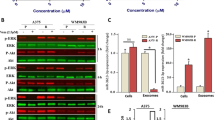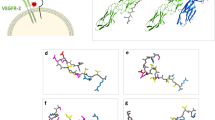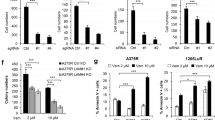Abstract
Targeting molecules involved in tumor invasion may be useful in future strategies for melanoma treatment aiming to reduce the progression of the disease and prevention of metastatic spread. During melanoma progression to metastatic disease, a significant overexpression of melanoma cell adhesion molecule CD146 occurs. It has been correlated with tumor progression and metastatic potential. Various approaches for targeting CD146 in melanoma cells have been exploited and CD146 has been shown to be a promising target for antitumor therapy. In our study, a new approach of gene electrotransfer (GET) of small interfering RNA (siRNA) against CD146 was evaluated in human malignant melanoma cells. We demonstrated for the first time that downregulation of CD146 mRNA after GET is more significant than after lipid-mediated transfer. Furthermore, reduced cell migration and invasion of melanoma cells was observed after GET of therapeutic siRNAs. GET of therapeutic siRNAs also reduced cell survival, but had no effect on cell proliferation. These findings suggest that targeting CD146 expression by GET of siRNAs against CD146 is effective for reducing the metastatic potential of melanoma cells in vitro. CD146 is therefore a potential target for the development of adjuvant therapies for metastatic melanoma.
This is a preview of subscription content, access via your institution
Access options
Subscribe to this journal
Receive 12 print issues and online access
$259.00 per year
only $21.58 per issue
Buy this article
- Purchase on Springer Link
- Instant access to full article PDF
Prices may be subject to local taxes which are calculated during checkout

Similar content being viewed by others
References
Strojan P . Role of radiotherapy in melanoma management. Radiol Oncol 2010; 44: 1–12.
Cemazar M, Jarm T, Sersa G . Cancer electrogene therapy with interleukin-12. Curr Gene Ther 2010; 10: 300–311.
Shih IM . The role of CD146 (Mel-CAM) in biology and pathology. J Pathol 1999; 189: 4–11.
Wu GJ, Fu P, Wang SW, Wu MW . Enforced expression of MCAM/MUC18 increases in vitro motility and invasiveness and in vivo metastasis of two mouse melanoma K1735 sublines in a syngeneic mouse model. Mol Cancer Res 2008; 6: 1666–1677.
Kang Y, Wang F, Feng J, Yang D, Yang X, Yan X . Knockdown of CD146 reduces the migration and proliferation of human endothelial cells. Cell Res 2006; 16: 313–318.
Mills L, Tellez C, Huang S, Baker C, McCarty M, Green L et al. Fully human antibodies to MCAM/MUC18 inhibit tumor growth and metastasis of human melanoma. Cancer Res 2002; 62: 5106–5114.
Cemazar M, Sersa G, Wilson J, Tozer GM, Hart SL, Grosel A et al. Effective gene transfer to solid tumors using different nonviral gene delivery techniques: electroporation, liposomes, and integrin-targeted vector. Cancer Gene Ther 2002; 9: 399–406.
Quaglino P, Osella-Abate S, Marenco F, Nardo T, Gado C, Novelli M et al. FoxP3 expression on melanoma cells is related to early visceral spreading in melanoma patients treated by electrochemotherapy. Pigm Cell Melanoma Res 2011; 24: 734–736.
Todorovic V, Sersa G, Mlakar V, Glavac D, Cemazar M . Assessment of the tumourigenic and metastatic properties of SK-MEL28 melanoma cells surviving electrochemotherapy with bleomycin. Radiol Oncol 2012; 46: 32–45.
Watson-Hurst K, Becker D . The role of N-cadherin, MCAM and beta3 integrin in melanoma progression, proliferation, migration and invasion. Cancer Biol Ther 2006; 5: 1375–1382.
Acknowledgements
Financial support for this work was provided by the Slovene Research Agency (program numbers P3-0003 and J3-0485-054). Research was conducted within the scope of the EBAM European Associated Laboratory (LEA) and within Cost action TD1104. We acknowledge Mr Martin Cregeen for proofreading and editing the manuscript.
Author information
Authors and Affiliations
Corresponding author
Ethics declarations
Competing interests
The authors declare no conflict of interest.
Additional information
Supplementary Information accompanies the paper on Cancer Gene Therapy website
Supplementary information
Rights and permissions
About this article
Cite this article
Todorovic, V., Sersa, G. & Cemazar, M. Gene electrotransfer of siRNAs against CD146 inhibits migration and invasion of human malignant melanoma cells SK-MEL28. Cancer Gene Ther 20, 208–210 (2013). https://doi.org/10.1038/cgt.2013.3
Received:
Revised:
Accepted:
Published:
Issue Date:
DOI: https://doi.org/10.1038/cgt.2013.3
Keywords
This article is cited by
-
MCAM, as a novel receptor for S100A8/A9, mediates progression of malignant melanoma through prominent activation of NF-κB and ROS formation upon ligand binding
Clinical & Experimental Metastasis (2016)
-
The multifaceted role of CD146/MCAM in the promotion of melanoma progression
Cancer Cell International (2015)
-
Mcam Silencing With RNA Interference Using Magnetofection has Antitumor Effect in Murine Melanoma
Molecular Therapy - Nucleic Acids (2014)
-
Therapeutic potential of siRNA and DNAzymes in cancer
Tumor Biology (2014)



